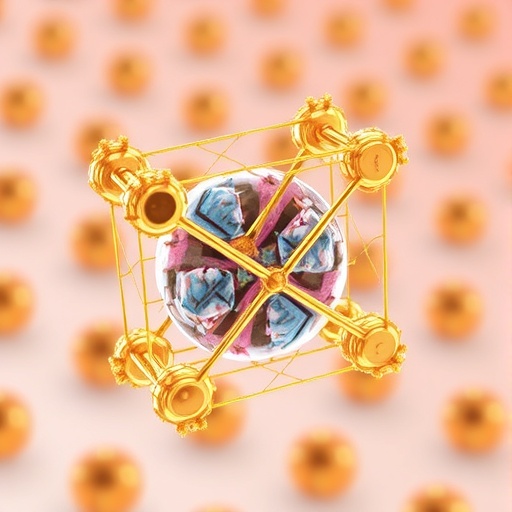In the quest for advanced materials that can revolutionize the fields of electrochemistry and gas sensing, researchers have recently made significant strides by developing green-synthesized Yttria-stabilized Zirconia (YSZ)/polypyrrole nanocomposites. This innovative fusion of materials not only showcases the potential of sustainable synthesis methods but also brings forth enhanced characteristics that could lead to groundbreaking applications in various sectors. YSZ is known for its exceptional ionic conductivity, which makes it an excellent candidate for electrochemical devices. When coupled with polypyrrole, a conducting polymer, the resulting nanocomposite presents an intriguing platform for improving performance in sensor technologies.
The synthesis process employed in producing these YSZ/polypyrrole nanocomposites emphasizes environmentally friendly methodologies. Traditional synthesis techniques often involve harsher chemicals and procedures that lead to hazardous waste. In stark contrast, green synthesis leverages natural resources, minimizing chemical inputs and environmental damage. This approach does not only yield highly conductive materials but also aligns with global goals towards sustainable development in material science.
A noteworthy aspect of these nanocomposites is their enhanced electrochemical properties. The unique architecture created by integrating YSZ with polypyrrole facilitates increased ionic and electronic conductivity. Consequently, this allows for faster charge transport, which is crucial in many electrochemical applications, such as fuel cells and batteries. These devices depend heavily on the ability of materials to conduct ions efficiently, making the newly developed nanocomposites a promising alternative to conventional materials.
Moreover, the butane gas sensing capabilities of the YSZ/polypyrrole nanocomposites reveal their potential for use in environmental monitoring and safety applications. Given the growing concerns regarding air quality and gas emissions, having efficient sensors is more crucial than ever. The remarkable sensing performance can be attributed to the high surface area provided by the nanocomposite structure. This enhanced surface interaction ensures that even trace amounts of butane can be detected with high sensitivity and selectivity, indicating a noteworthy advancement in sensor technology.
The research surrounding these nanocomposites also dives into the mechanisms that underpin their performance. The interaction between the YSZ and polypyrrole at the nanoscale allows for a complex interplay of charge carriers. When butane gas molecules come into contact with the sensor, they interact with the surface of the nanocomposite, leading to changes in conductivity that can be measured and interpreted. This response is pivotal for real-time monitoring applications, offering rapid feedback in real-world settings.
Analytically, the researchers conducted rigorous testing to ensure the reliability of these nanocomposites in practical applications. Different variables such as temperature, humidity, and exposure time were meticulously controlled in order to simulate real-life conditions that these sensors would face. The results were promising, indicating that the new sensors could withstand varied environmental stimuli without significant degradation in performance.
In addition to their technical merits, the economic implications of adopting such nanocomposites cannot be overlooked. The use of green synthesis methods not only reduces costs associated with raw materials but also diminishes the overall ecological footprint of producing advanced materials. As industries pivot towards more sustainable practices, the integration of these biocompatible materials can lead to lower production costs and increased competitiveness in the market.
Future directions in the research of YSZ/polypyrrole nanocomposites could lead to further enhancements in their properties. By altering the ratios of YSZ to polypyrrole or introducing additional nanomaterials, researchers can fine-tune the characteristics of the composites for even more specialized applications. Exploring these parameters could provide insights into optimizing performance in various environmental and industrial settings.
The implications extend beyond just the realm of electrochemical and gas sensing. The fundamental properties of these nanocomposites suggest they could also have applications in areas such as biomedical devices and energy storage systems. As the landscape of material science continues to evolve, the versatility of YSZ/polypyrrole nanocomposites highlights their potential in an array of future technologies.
With the ongoing development of smart technologies and the Internet of Things (IoT), the demand for reliable, efficient gas sensors is expected to surge. The YSZ/polypyrrole sensors paves the way for innovations in this space, potentially leading to seamless integration with existing smart systems for better monitoring and data analysis. This aligns with the current trend towards digitalization in industrial applications, where having insights gleaned from real-time data can transform operations and efficiency.
The collaborative nature of this research effort underscores the importance of interdisciplinary approaches in material science. Experts across fields such as chemistry, engineering, and environmental science contributed to the successful development of these nanocomposites. Emphasizing team collaboration not only nurtures innovation but also accelerates the transfer of knowledge between disciplines, ultimately enriching the field.
In conclusion, the development of green-synthesized YSZ/polypyrrole nanocomposites marks a promising advancement in the arena of material science. Their exceptional electrochemical properties and enhanced gas sensing capabilities will have a profound impact on various applications. This research not only reinforces the potential of green synthesis in producing advanced functional materials but also sets a precedent for future innovations that can tackle environmental challenges in a sustainable manner.
As the global emphasis on sustainability and efficiency continues to grow, further exploration into these nanocomposites could yield exciting developments that push the frontiers of technology. With ongoing research and collaboration, the YSZ/polypyrrole nanocomposites stand as a beacon of possibility in the pursuit of smarter, more effective materials.
Subject of Research: Development of Green-synthesized YSZ/polypyrrole Nanocomposites for Electrochemical and Gas Sensing Applications
Article Title: Green-synthesized YSZ/polypyrrole nanocomposites for enhanced electrochemical and butane gas sensing applications.
Article References:
S, P., D, K., G.S, N. et al. Green-synthesized YSZ/polypyrrole nanocomposites for enhanced electrochemical and butane gas sensing applications.
Ionics (2025). https://doi.org/10.1007/s11581-025-06684-5
Image Credits: AI Generated
DOI: https://doi.org/10.1007/s11581-025-06684-5
Keywords: Nanocomposites, Green Synthesis, YSZ, Polypyrrole, Electrochemical Applications, Gas Sensing, Sustainable Materials.
Tags: advanced sensor materialsconducting polymer integrationeco-friendly nanocompositeselectrochemical applicationsenvironmental impact reductiongas sensing technologiesgreen synthesis methodsionic conductivity improvementnanocomposite performance enhancementsustainable electrochemistrysustainable material developmentYSZ polypyrrole synthesis





